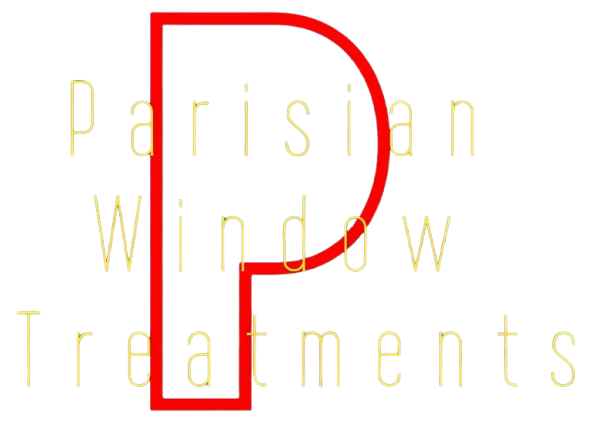Window blinds are an essential part of home décor, providing privacy, light control, and aesthetic value. Over time, you might wonder if it’s possible to paint window blinds to refresh their look instead of buying new ones. In this article, we’ll discuss the types of blinds that are suitable for painting, the process of painting them, and whether it’s worth the effort. Whether you’re considering updating your custom blinds or experimenting with color, we’ll provide expert tips and guidance. Let’s dive in and explore everything you need to know about painting window blinds!
Introduction: Why You Might Want to Paint Your Window Blinds
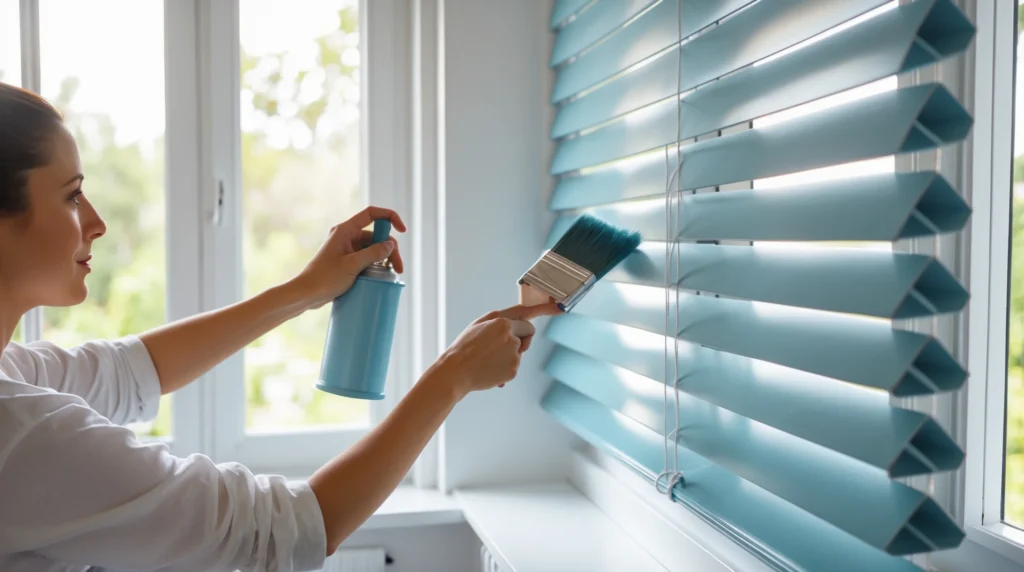
Window blinds come in a variety of styles, such as custom window blinds, cellular shades, and roller shades for windows. However, over time, even the most durable blinds may begin to look outdated or worn out. Instead of purchasing entirely new blinds, you may wonder, Can you paint window blinds? The answer is yes! Painting your window blinds is an affordable way to refresh their appearance and match them to your current home décor. It’s also a great way to get more use out of blinds that are still in good condition but need a little update.
In this article, we’ll explore which types of blinds are suitable for painting, how to paint them, and the benefits of doing so. By the end, you’ll have all the information needed to decide if painting your blinds is the right choice for your home.
Understanding the Types of Blinds You Can Paint
When it comes to painting window blinds, not all blinds are created equal. Some materials are more paint-friendly than others, and knowing which ones are suitable for painting is crucial to achieving a great result.
- Faux Wood Blinds: These are made of synthetic materials and are one of the easiest types of blinds to paint. They hold paint well and offer a smooth, clean finish when painted properly.
- Mini Blinds: Typically made of metal or vinyl, mini blinds can also be painted, although they may require a bit more preparation to get a smooth finish.
- Custom Window Blinds: If you’ve invested in custom blinds, you may be hesitant to paint them, but these can be painted too. Just make sure the material is paintable (e.g., wood, vinyl, or composite) before beginning the process.
- Cellular Shades and Honeycomb Shades: These are generally not recommended for painting due to their delicate structure and the materials used. The paint may not adhere well and could damage the shades. Instead, consider replacing them with new ones if you want a fresh look.
In the next sections, we’ll dive deeper into the specifics of painting blinds made of various materials and provide step-by-step guidance on how to go about it.
Can You Paint Roller Shades or Cellular Blinds?
Roller shades are incredibly popular due to their simplicity and versatility. If you have roller shade blinds in your home, you might be wondering if they can be painted to suit your new décor. The short answer is yes, roller shades for windows can be painted, but there are a few things to consider before getting started. The fabric or vinyl used in many roller shades may require special paint to adhere properly. For the best results, use fabric or vinyl-friendly paints and be sure to clean and prime the surface beforehand.
On the other hand, cellular shades (also known as honeycomb shades) are not typically suitable for painting. These shades are made of paper-like materials designed to trap air, providing insulation. Painting them could cause damage to the material, leading to poor results and compromised functionality. If you’re looking to update your cellular window shades, it’s better to opt for a replacement rather than attempting to paint them.
How to Paint Window Blinds for a Fresh New Look
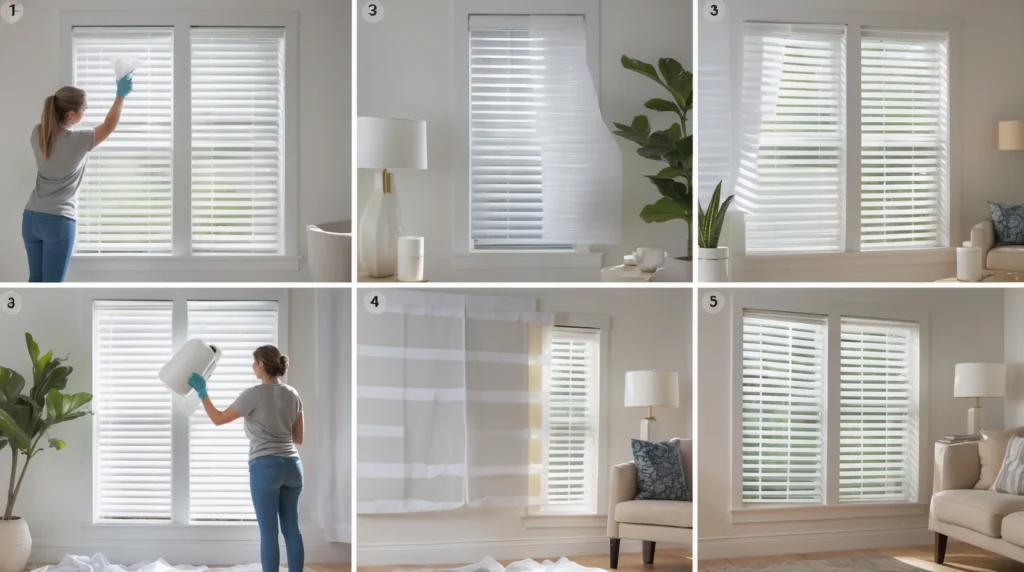
Now that we know which blinds can be painted, let’s explore the process. Here’s a step-by-step guide on how to paint window blinds to achieve a fresh new look:
- Remove the Blinds: Start by removing the blinds from the window. This will make the painting process much easier and help avoid any spills or mess on your walls.
- Clean the Blinds: Before painting, it’s essential to clean your blinds thoroughly. Dust, dirt, and grime can interfere with the paint’s adhesion, so use a mild cleaning solution and a cloth to wipe down each slat.
- Protect the Area: Lay down a drop cloth or newspaper to protect the surface where you’ll be painting. You may also want to use painter’s tape to protect any hardware or cords that you don’t want to get paint on.
- Prime the Blinds: Apply a coat of primer designed for the material of your blinds. For faux wood blinds or custom window blinds, a high-quality spray primer will work best.
- Apply the Paint: Once the primer has dried, it’s time to apply your paint. Use a spray paint for an even coat or a brush for a more controlled application. If you’re painting roller shades for windows or mini blinds, be sure to use the right paint for the material, such as vinyl or fabric paint.
- Let It Dry: Allow the paint to dry completely before reassembling and rehanging the blinds.
By following these steps, you can easily transform your blinds into a fresh, stylish addition to your home.
What Types of Blinds Are Paintable?
When considering whether to paint your blinds, you should first determine if the material is compatible with paint. Faux wood blinds and mini blinds are ideal candidates because they are made of materials that accept paint well. On the other hand, more delicate blinds like cellular shades or honeycomb shades may not be suitable for painting. Here’s a quick list of blinds that are typically safe to paint:
- Faux Wood Blinds
- Custom Blinds (Wood, Vinyl, or Composite)
- Mini Blinds (Metal or Vinyl)
- Roller Shades (Fabric or Vinyl)
- Zebra Blinds (Certain materials)
For custom window shades, always check with the manufacturer or consult a professional to determine if they are paintable.
Tips for a Professional Finish When Painting Blinds
Achieving a professional finish when painting your window blinds is essential for a polished, long-lasting result. Here are some expert tips to ensure the best possible outcome:
- Use the Right Paint: Always choose a paint that is compatible with the material of your blinds. For example, use a spray paint designed for metal if you’re painting mini blinds or roller shade blinds.
- Apply Thin Coats: Avoid thick layers of paint, which can result in drips and an uneven finish. Apply thin, even coats and allow each coat to dry before adding another.
- Use a Spray Gun or Aerosol Paint: A spray gun or aerosol paint is often the best choice for painting blinds, as it provides an even and smooth coat without brush marks.
- Protect the Hardware: Use painter’s tape to cover any hardware or cords to prevent them from getting painted.
By following these tips, you can achieve a professional finish that makes your blinds look as good as new.
Choosing the Right Paint for Your Blinds
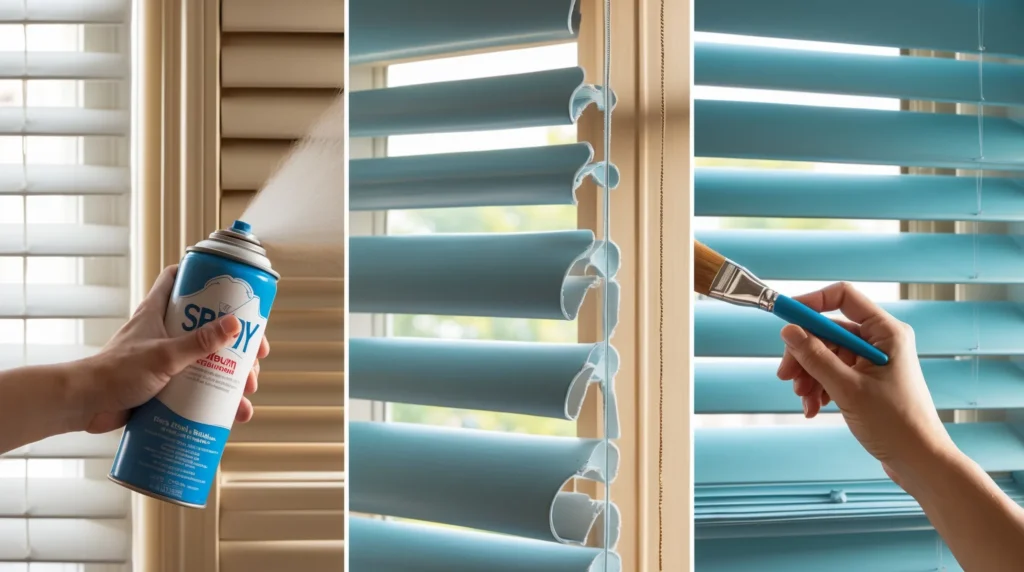
Choosing the right paint for your blinds is crucial for both the finish and longevity of the paint job. Here’s a breakdown of the best types of paint for different blinds:
- Spray Paint: For faux wood blinds, mini blinds, and roller shades for windows, spray paint is ideal because it provides an even finish and is easy to apply.
- Acrylic Paint: If you’re painting custom window blinds, acrylic paint is a great choice. It adheres well to most surfaces and provides a durable finish.
- Vinyl or Fabric Paint: For roller shade blinds or custom window shades, use vinyl or fabric-specific paint to ensure proper adhesion and flexibility.
How to Get Your Blinds Ready for Painting
Proper preparation is key to a successful paint job. Here’s how to get blinds ready for painting:
- Clean Thoroughly: Dust and dirt can prevent paint from adhering, so make sure your blinds are clean.
- Remove Hardware: Take off any hooks, cords, or decorative elements that could get in the way of painting.
- Light Sanding: For some materials like wood, a light sanding may be necessary to help the paint adhere better.
By spending a little extra time on prep work, your painted blinds will look better and last longer.
The Best Window Blinds for Custom Painting
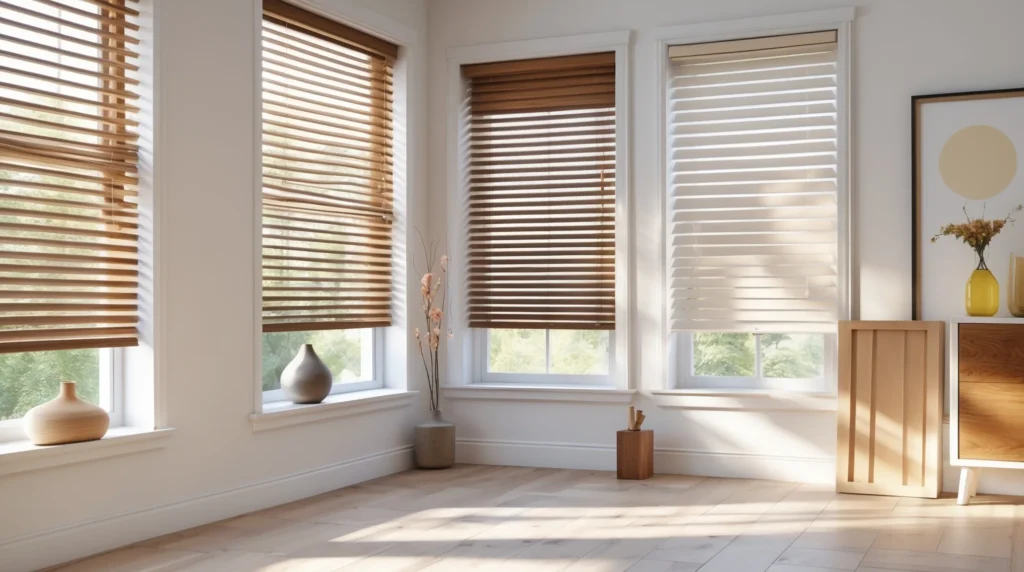
While many types of blinds can be painted, some are better suited for the task. Faux wood blinds are a top choice for painting because they are durable and hold paint well. Similarly, custom window blinds made from wood or composite materials are often perfect for custom painting.
When choosing blinds to paint, look for materials that can handle the application of paint and will continue to look great over time.
Is Painting Window Blinds Worth the Effort?
Before you start painting your window blinds, it’s important to consider whether it’s worth the effort. Painting window blinds can be a cost-effective way to update your home’s look, especially if your blinds are still in good condition. It’s a more affordable option compared to purchasing new custom window treatments. However, if your blinds are heavily damaged or outdated, it may be more practical to invest in new ones.
Ultimately, painting your blinds offers a chance to customize them to fit your style, save money, and extend the life of your window treatments.
Window Blinds Painting Services in Paris, TX
If you’re in Paris, TX, and don’t have the time or tools to paint your window blinds yourself, consider reaching out to Parisian Window Treatment for professional assistance. We specialize in custom window treatments and can help transform your old blinds into something fresh and new. Whether you need roller shades for windows or custom blinds, we’ve got you covered!
Painting your window blinds can be a fun and rewarding project, allowing you to refresh your home’s look without spending a fortune on new treatments. If you’re ready to get started or need help with professional services, don’t hesitate to contact Parisian Window Treatment in Paris, TX. Let us help you achieve the perfect look for your home!
